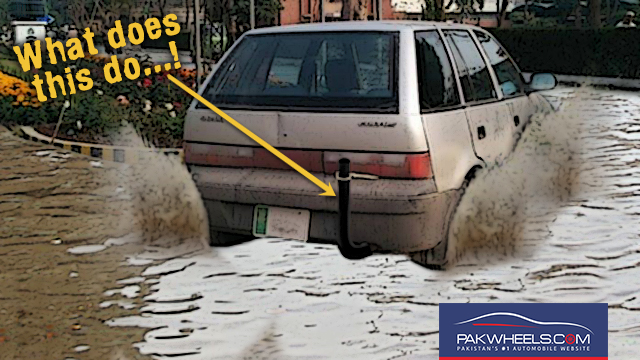The Logic Behind The Rubber Tailpipe Extension In Rain
With Pakistan going through the monsoon time of the year, we better remain cautious while driving through flooded streets of our city. On a heavily flooded street, it is a common sight that some cars drive through the water very easily while some struggle and eventually come to a halt. What are the other drivers doing that makes them cross the “river” like a piece of cake?
Cars that have no problem driving through water are mostly fitted with an extended rubber tailpipe. Now we already know that the car stalls if there is too much water in the silencer or muffler but a misconception some of us have is that this water travels all the way from the tailpipe through the muffler/silencer into the resonator and inside the engine cylinder. If you don’t have this misconception, good for you. But why does this happen? What does water in downpipe has anything to do with your engine going off? What benefit does a rubber extension give?
Now, usually you need to rev your engine high when crossing a flooded road to prevent any water getting inside your car’s silencer. You’d be fine if you do this. But if you lift your throttle to change gear or whatever the reason, the car’s exhaust pipe works as a vacuum cleaner and sucks all the water in. Once these pipes are flooded, your car engine goes off because the exhaust gases cant find a way to escape the engine cylinder. The water doesn’t travel inside your engine all the way up through the downpipes, rather it is choked. Here comes the role of the rubber extension pipe. It works as a snorkel that lets your car breath even when your tailpipe is underwater. You can release the throttle and change gears whenever you want. Your car won’t stall due to water going in and choking your silencer.
Related: Learn more about driving in the rain.
Another reason for cars not being able to cross the water is when the water is so much that it touches the air-intake. When it is in contact with the air-intake, the engine sucks in water rather than air so there’s water in your cylinders now. Under such scenarios, do not attempt to start your car as it may damage connecting rods and your engine might need an overhaul. Instead just unscrew the spark plugs and pull them out. Turn on the switch and let the self complete 3 to 4 cycles. Fit the plugs back in and you’re good to go.
Such small tips are quite useful in driving through water and you can try fixing your problem once you know how everything works.



At last some one wrote a worth reading article. Apart from those jokers who don’t even know what they are writing.
I agree with Hasan Rizvi
good job OP well written to the point and informative
Rain?
come at me breh
You know so much about articles why don’t you write some.